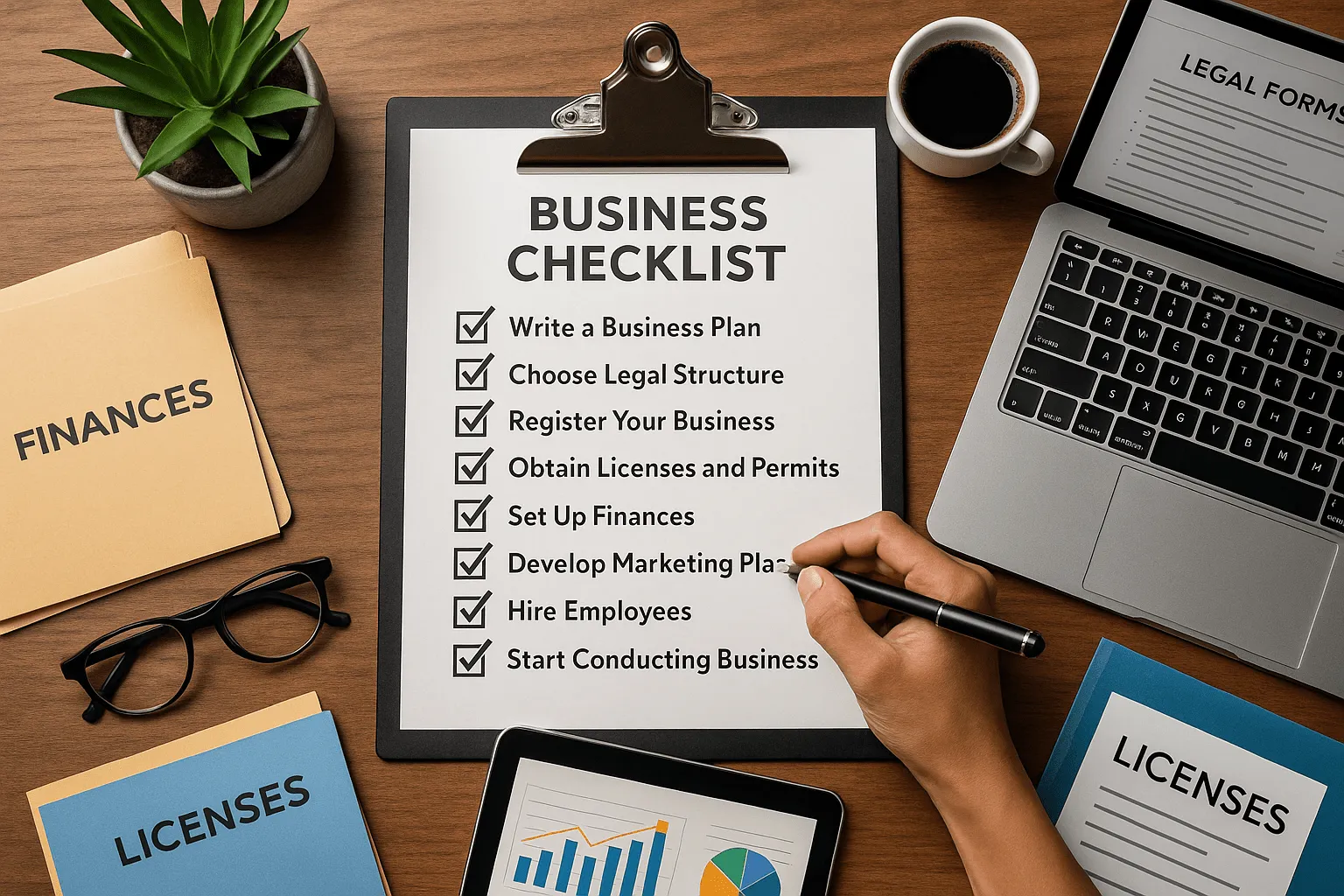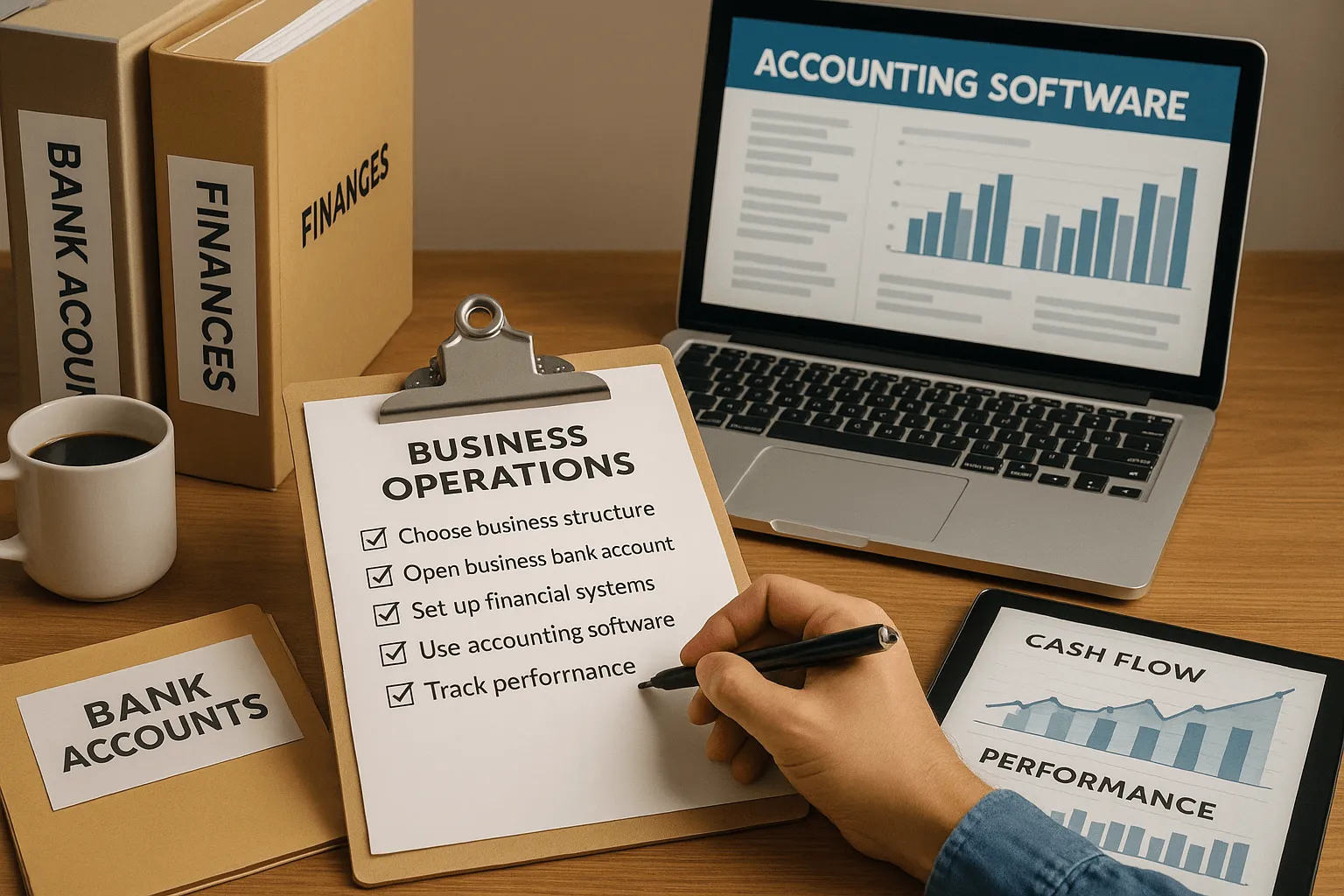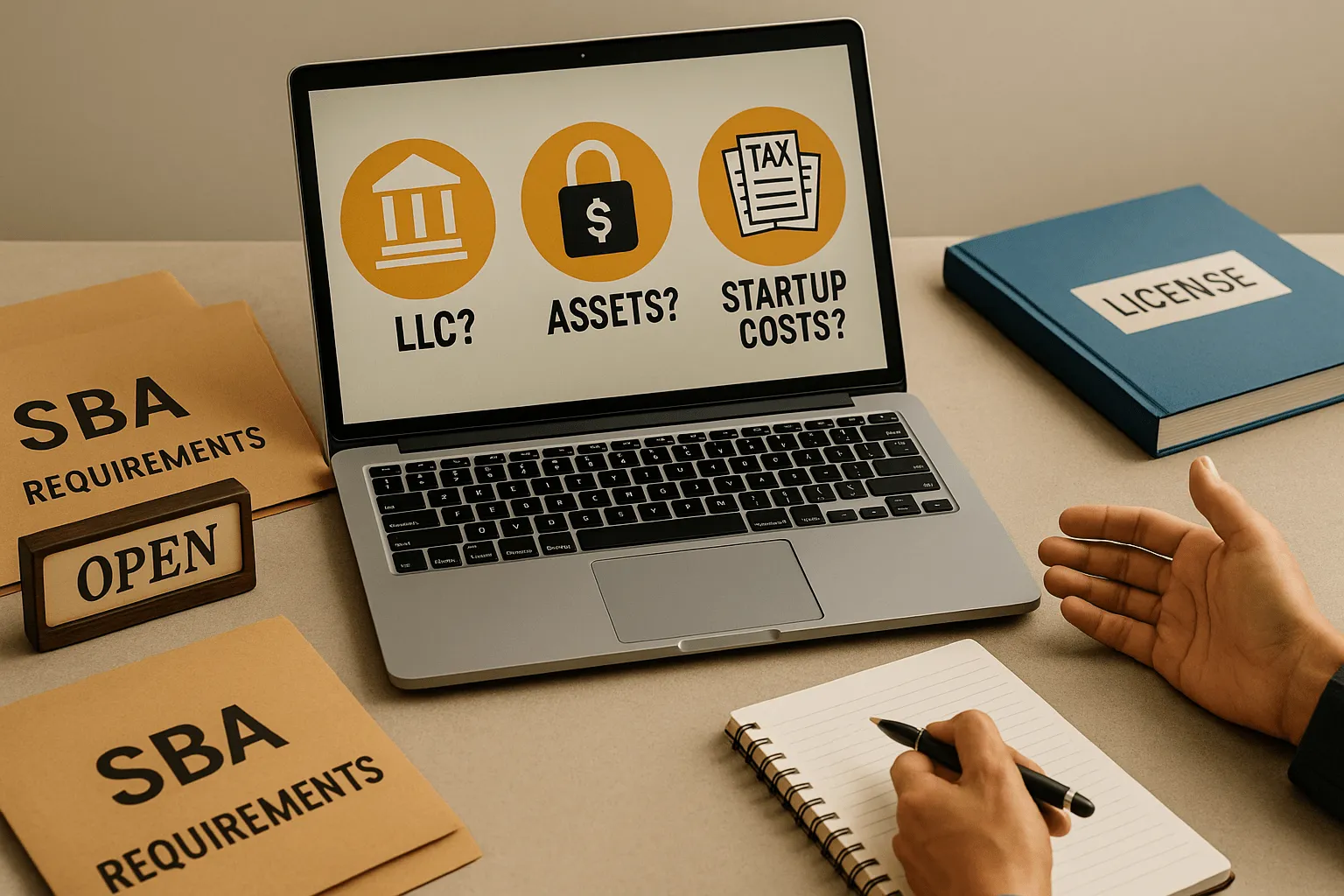Launching a business in 2025 sounds exciting—until you realize how easy it is to miss something important. From picking the right business structure to getting your licenses and handling taxes, the details can sneak up fast.
In fact, over 5 million new business applications were filed in the U.S. in 2023 (U.S. Census Bureau)—but not all made it past year one.
This starting business checklist helps you avoid rookie mistakes and set up your dream business the right way.
Why You Need a Starting Business Checklist in 2025

A starting business checklist helps you launch the right way. Many people skip steps and face problems later. In fact, the U.S. Small Business Administration says about 20% of new businesses fail in the first year—mostly due to poor planning.
Here’s why you need one:
- It keeps your business structure, licenses and permits, and bank account tasks in order
- It reminds you to register your business, plan your marketing strategy, and track business expenses
- It helps protect your personal assets by treating your business as a separate legal entity
- It prepares you to pay taxes, manage cash flow, and set up the right accounting software
“Most businesses fail not because of the idea, but because they don’t follow a process.” — SCORE.org
A clear checklist gives you confidence, helps avoid startup costs mistakes, and gets your business off to a strong start.
Business Checklist: Key Steps to Launch Your Business the Right Way

1. Finalize Your Business Idea and Target Customers
Before anything else, you need a solid business idea. Know what you're offering and who it's for.
How to do it:
- Think about problems you can solve
- Identify your target customers—people who need what you sell
- Run a quick market analysis to check demand and competitors
- List your product or service in simple words
“Knowing your audience is half the battle. A good idea needs a real market.” — SCORE.org
2. Choose a Legal Structure
This decides how your business is taxed and protected legally. Your choice affects personal assets, business ownership, and how you pay taxes.
How to do it:
- Start as a sole proprietorship if you want something simple
- Consider a limited liability company (LLC) to protect your assets
- Learn the differences between legal structure options like corporations and limited liability companies
Choosing the right structure early can save you money and legal trouble.
3. Register Your Business Name and Get a Business License
You can’t run a business without making it official. This step ensures you’re legally allowed to operate.
How to do it:
- Pick a business name that’s not taken
- Visit your state’s office or state government website to register it
- Apply for the needed business license or licenses and permits based on your industry and business location
Having the correct licenses protects you and builds trust with customers.
4. Apply for an Employer Identification Number (EIN)
An EIN functions like a Social Security number for your business. You'll need it to hire employees or open a business bank account.
How to do it:
- Apply online at the IRS website—it’s free
- Even home based businesses or freelancers often need one
- You may see it called Employer Identification Number EIN in some places
5. Open a Business Bank Account
You must separate personal money from your business money. This step protects your company’s legal identity and keeps your business finances clean.
How to do it:
- Choose a bank that offers good small business features
- Open a business bank account, not a personal one
- Set up a company bank account to track cash flow, business expenses, and deposits
- This will help you later with business taxes, tax deductions, and paying taxes
“Mixing personal and business funds is one of the top financial mistakes small business owners make.” — U.S. Chamber of Commerce
6. Understand Business Taxes and Sales Tax

Every new business must follow tax rules. You’ll pay taxes on the money you make and may need to collect sales tax too.
How to do it:
- Register for a sales tax permit through your state government
- Track your income and know when to pay taxes
- Know your business tax deadlines and set reminders for due dates
- Learn about federal tax, business taxes, and tax deductions
Tip: Use the IRS website to understand your obligations as a small business.
“Many businesses pay penalties just because they miss deadlines or don't know what taxes apply.” – U.S. Small Business Administration
7. Set Up Accounting and Manage Cash Flow
You need to track how money comes in and goes out. That’s where accounting software and cash flow tools help.
How to do it:
- Use easy-to-learn accounting software like QuickBooks or FreshBooks
- Keep records of business expenses and money earned
- Review your business finances weekly
- Forecast your income and make smart decisions
Why it matters: Good cash flow keeps your business alive. Without it, you can't pay bills or grow.
8. Secure Business Insurance
Business insurance protects you if something goes wrong—like theft, accidents, or damage.
How to do it:
- Start with general liability coverage
- Look into workers compensation and unemployment insurance if you plan to hire employees
- Some industries require special licenses and permits to stay insured
Real-world advice: Many small business owners don’t think about insurance until it’s too late. One mistake could cost you thousands.
9. Create a Marketing Strategy
People won’t find your business unless you tell them about it. A good marketing strategy brings in customers.
How to do it:
- Know your target audience and what they care about
- Set up social media accounts and post regularly
- Develop a marketing plan with real goals and simple actions
- Focus on your target market with smart content
“Marketing is no longer about the stuff you make but the stories you tell.” – Seth Godin
10. Set Up to Accept Credit Card Payments
Most people pay with cards today. Your business must be ready to accept credit card payments.
How to do it:
- Use secure tools like Square or Stripe
- Make sure you can accept both debit and credit card payments
- Keep payment records in your company bank account
- Ask your bank about linking a business bank account to your payment processor
This step builds trust with customers and makes paying easy.
11. Plan for Hiring Employees (If Needed)
If your business grows, you may need to hire employees to help you manage tasks. This means taking legal steps before bringing anyone on board.
How to do it:
- Apply for an employer identification number if you haven’t already
- Check your state government website for hiring rules
- Learn about workers compensation and unemployment insurance
- Set up a payroll system to pay employees on time
- Clearly define each job role and responsibility
Real Talk: According to the U.S. Small Business Administration, small business owners who plan hiring early avoid legal troubles later.
"Hiring even one employee means new tax rules and legal responsibilities. Be ready." — SBA.gov
Tip: Don’t rush. Start with part-time or freelance help until you’re ready for full-time staff.
How to Create a Business Plan That Guides Every Step

- Start with a Clear Business Idea: Begin with one strong business idea. Ask: What problem do you solve? Who needs your product? Many small business owners succeed by keeping it simple and solving real problems.
- Know Your Market: Understand your target market. Do a basic market analysis. Find your potential customers. Ask questions. Use free tools like Google Trends. Knowing your audience saves time and money later.
- List Startup Costs and Business Expenses: Write down all startup costs and business expenses. Think licenses, equipment, software, and even office furniture. Planning this early helps avoid surprise bills.
- Plan Your Business Operations: Map how you’ll conduct business daily. How will you ship, sell, support? Use tools to streamline operations. This helps avoid chaos and builds customer trust.
- Create Financial Projections: Even simple financial projections show if your idea can make money. Estimate your income, business taxes, and costs. Many new businesses skip this—but don’t. It shows if your plan works.
- Build a Marketing Plan: A strong marketing plan helps you reach the right people. Include social media, local ads, and email. It connects your marketing strategy with actual customer actions.
- Set Measurable Goals: Set short, clear goals. Example: “Get 10 customers in 30 days.” Small wins keep you going.
- Include Key Documents: Save time by collecting key files now. Include your business license, insurance papers, and employer identification number (EIN). These are often needed to register your business, open a business bank account, and stay compliant.
How to Set Up Your Business Operations the Smart Way

A smart starting business checklist goes beyond just launching—it helps your business run smoothly every day. Here’s how to build strong business operations from the start.
1. Choose the Right Business Structure
Your business structure decides how you pay taxes and protect your personal assets.
- A sole proprietorship is simple, but it doesn't protect your personal money.
- A limited liability company (LLC) offers safety by making your business a separate legal entity.
2. Set Up Basic Financial Systems
Track where your money goes. You’ll need this when filing your business taxes and asking for a business loan.
- List your startup costs (office furniture, permits, marketing)
- Track business expenses daily
3. Use Accounting Software from Day One
Don’t wait till tax season. Use accounting software now to manage cash flow, send invoices, and track bills.
- Tools like QuickBooks or Zoho help small business owners stay organized
- They also help you pay taxes on time and avoid fines
4. Automate and Organize Daily Tasks
Use tools to streamline operations like email, payments, and inventory.
- Set due date reminders
- Automate payroll to pay employees accurately
5. Track and Improve Performance
Monitor your business operations regularly.
- Use reports to fix problems early
- Adjust your marketing strategy or pricing if needed
- Explore career opportunities at Alore
“The smartest companies track what works and pivot fast.” — Forbes Business Council
FAQs: What New Business Owners Ask Most

1. Should I form an LLC or sole proprietorship first?
It depends on how much risk you're okay with. A sole proprietorship is easy to set up but doesn’t protect your personal assets. An LLC (limited liability company) is safer—it separates your personal money from your business money.
2. How do I protect my personal assets?
Pick the right legal setup—like an LLC. Get business insurance to cover damages, lawsuits, or theft. And always keep your business bank account separate from your personal one. This keeps your business finances clean and your personal assets safe if problems come up.
3. What is required by the small business administration and small business administration's site?
The Small Business Administration (SBA) provides free resources, funding help, and legal info. Visit the small business administration's site to check what your state or city needs—like licenses and permits, or help with your business plan.
They also have tools to help you register your business and find a business loan if you need funding.
4. Can I get a tax break for startup costs?
Yes! The IRS allows you to deduct up to $5,000 in startup costs like market research, legal fees, or buying office furniture. Save your receipts and talk to a tax advisor.
Also, track all costs using accounting software to stay on top of your business tax filings.
Conclusion
Starting a business takes work, but a clear starting business checklist makes it easier. Use your business plan as your map. Choose the right structure, like an LLC or sole proprietorships, based on your goals. Don’t skip legal requirements like business licenses or permits. Even small businesses must follow state and federal government rules. Most businesses fail from missed steps—don’t let yours be one. Plan smart. Own your business journey.








